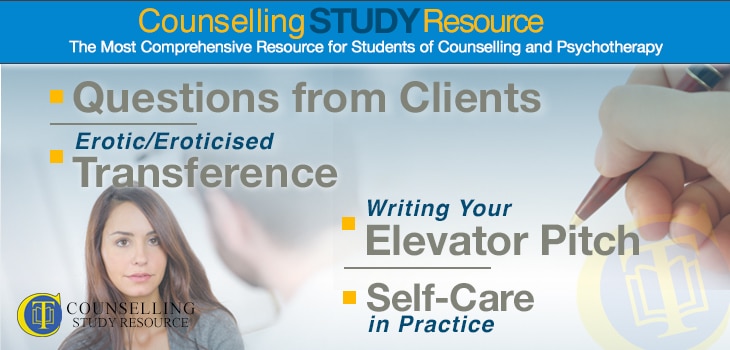
Questions from Clients – Erotic/Eroticised Transference – Writing Your Elevator Pitch – Self-Care in Practice
In episode 21 of the Counselling Tutor Podcast, Rory Lees-Oakes and Ken Kelly talk about what to do when a client asks us a question. ‘Theory with Rory’ looks at erotic and eroticised transference, while ‘Person-Centred Business’ explains how to create an ‘elevator pitch’ (concise statement of what you offer). Finally, the presenters discuss pacing and care for self in counselling placements.
Questions from Clients
In podcast 7, we looked at when and how to question clients; here, we cover the opposite – when clients ask us questions. This relates to self-disclosure and the decision on how much of ourselves to show a client. It can be tricky to balance the needs for congruence and for staying with the client’s journey. The key here is to look at what the client is asking and why – a general, conversational question at the start of end of a session may be a natural part of building a working relationship, but other questions may be inappropriately personal or advice-seeking. In these cases, the best response may be to explore the motivation for the client in asking the question.
Erotic and Eroticised Transference
Sometimes, clients may experience romantic and/or erotic feelings towards their counsellor. Clients with a history of being in abusive or neglectful relationships (including those who have been groomed as children) may be particularly prone to this. Other clients may be attending counselling as a pretext to get close to the counsellor.
Rory explains the concepts of transference (in which clients take elements of past relationships and overlay them on present ones) and countertransference (the counsellor’s reaction to this). These concepts are explored fully in episode 3 of the Counselling Tutor Podcast.
Given that person-centred counsellors do display a humanistic form of love towards clients, this can be confusing for clients who have not experienced the core conditions before. A useful book for understanding the many different types of love is Erich Fromm’s The Art of Loving. Key to handling erotic and eroticised transference is understanding the motivation of the client, and having an appropriate strategy to deal with this.
In erotic transference, the client uses counselling to explore their sexual fantasies and desires, possibly flirting with the counsellor. However, this is grounded in reality, in that the client is aware that there will not be a romantic or erotic relationship with the counsellor. In this case, the nature of the material discussed does not affect the client’s ability to achieve their counselling goals, or to have a mature attachment style with others. Nonetheless, it is important for the counsellor to look at their own process and feelings, taking the issue to supervision – and personal counselling if need be.
In eroticised transference, however, the client’s whole aim in coming to counselling is to develop a romantic or sexual relationship with the counsellor. This overrides the client’s ability to develop self-awareness. In this situation, the counsellor needs to challenge the client. If the behaviour continues, then respectful referral to another counsellor is called for.
Free Handout Download
Erotic and Eroticized Transference
Writing Your Elevator Pitch
To be successful in private practice as a counsellor, it is important to be able to describe our service concisely. This is useful when putting an entry in a counselling directory, or producing a brochure or website. It is a form of selling.
Ken suggests following seven steps:
- Define who you are.
- Define what you do.
- Identify your ideal client, including their geographical location.
- Identify what is different about you and your service (your ‘unique selling point’ – USP)
- State what the reader needs to do next, e.g. how to contact you (the ‘call to action’ – CTA)
- Create an attention-grabbing hook to put right at the top (e.g. a headline and/or picture)
- Put it all together, in the minimum number of words possible to get your message across.
Self-Care in Practice
Rory and Ken discuss how to take care of self once you are on placement, While workload depends to an extent on the agency’s expectations, it is important to allow adequate breaks between clients (say, 15 or 30 minutes), and to learn to put aside clients’ issues between sessions. Rory describes a practice that a colleague found useful, storing clients’ issues away in an invisible ‘filing cabinet’, with some labelled ‘for supervision’.